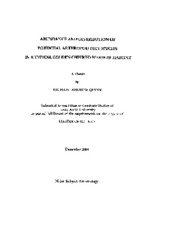| dc.creator | Quinn, Michael Andrew | |
| dc.date.accessioned | 2012-06-07T23:00:53Z | |
| dc.date.available | 2012-06-07T23:00:53Z | |
| dc.date.created | 2000 | |
| dc.date.issued | 2000 | |
| dc.identifier.uri | https://hdl.handle.net/1969.1/ETD-TAMU-2000-THESIS-Q518 | |
| dc.description | Due to the character of the original source materials and the nature of batch digitization, quality control issues may be present in this document. Please report any quality issues you encounter to digital@library.tamu.edu, referencing the URI of the item. | en |
| dc.description | Includes bibliographical references (leaves 62-68). | en |
| dc.description | Issued also on microfiche from Lange Micrographics. | en |
| dc.description.abstract | Arthropods have diverse functions in ecosystems, including providing food for resident breeding birds. The Golden-cheeked Warbler, Dendroica chrysoparia Sclater & Salvin is an endangered insectivorus song bird that nests exclusively in the juniper/oak woodlands of central Texas. This study was conducted to determine the availability of arthropods to the Golden-cheeked Warbler in its breeding habitat. Regular surveys were made of the arthropods on four tree species in which the warbler commonly forages. Arthropod abundance by tree species, height class, date, year and site was estimated. We surveyed the Long Hollow site for two years and the Shellberg site concurrently the second year. In general, the difference between our two study sites was significant but not as great as the differences among tree species within sites. Although the difference between sites for some taxa was significant, usually those differences were proportional across the tree species. Most taxa showed large differences in abundance between years, particularly those taxa that were associated with the two species of oaks in our study. In general, arthropods were more abundant at the lowest height class and were progressively less abundant with increasing height. Oaks supported large populations of hemipterans, homopterans and lepidopteran larvae early in the warbler's nesting season. Ashe juniper supported large populations of homopterans and lepidopteran larvae in the middle of the warbler's nesting season. Hymenopterans showed less of a tree species association than other orders and were abundantly available for a longer period of time than most orders. Beetles were most abundant in April. Spiders were the dominant arthropods in terms of overall abundance, with numbers gradually increasing throughout the period that the warbler is present in Texas. Twenty-two Golden-cheeked Warbler gizzards were available for examination. The dominant taxa in these gizzards were lepidopteran larvae, Hymenoptera, Araneae, Coleoptera, and Homoptera, closely matching the dominant arthropod taxa found in the warbler breeding habitat. | en |
| dc.format.medium | electronic | en |
| dc.format.mimetype | application/pdf | |
| dc.language.iso | en_US | |
| dc.publisher | Texas A&M University | |
| dc.rights | This thesis was part of a retrospective digitization project authorized by the Texas A&M University Libraries in 2008. Copyright remains vested with the author(s). It is the user's responsibility to secure permission from the copyright holder(s) for re-use of the work beyond the provision of Fair Use. | en |
| dc.subject | entomology. | en |
| dc.subject | Major entomology. | en |
| dc.title | Abundance and distribution of potential arthropod prey species in a typical Golden cheeked Warbler habitat | en |
| dc.type | Thesis | en |
| thesis.degree.discipline | entomology | en |
| thesis.degree.name | M.S. | en |
| thesis.degree.level | Masters | en |
| dc.type.genre | thesis | en |
| dc.type.material | text | en |
| dc.format.digitalOrigin | reformatted digital | en |


